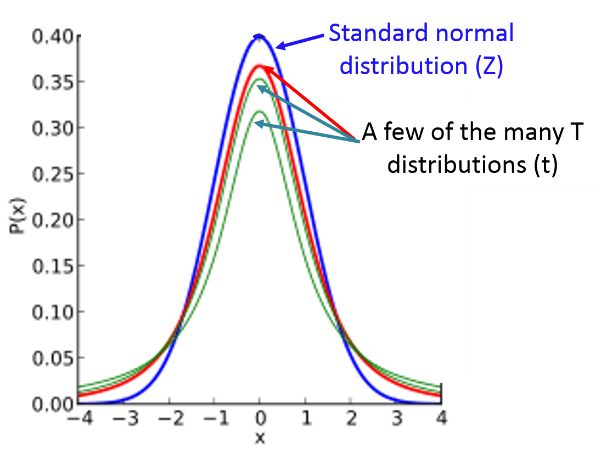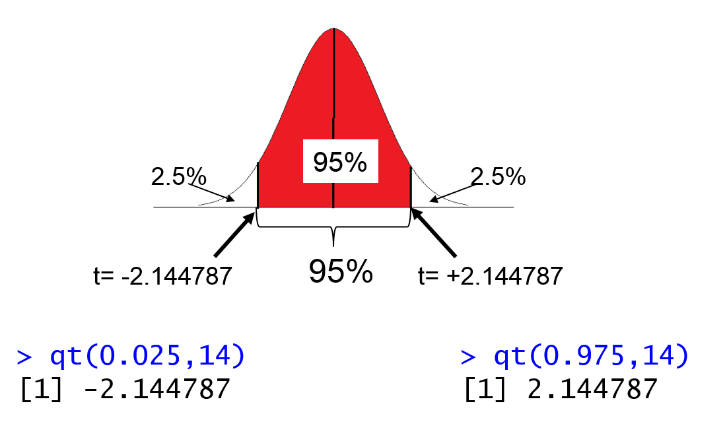when sample size increases what happens to confidence interval
Confidence Intervals for Sample Size Less Than thirty
In the preceding discussion we take been using s, the population standard deviation, to compute the standard error. Yet, we don't really know the population standard deviation, since we are working from samples. To get around this, we have been using the sample standard deviation (s) as an estimate. This is not a trouble if the sample size is 30 or greater because of the primal limit theorem. Even so, if the sample is small (<30) , we accept to adjust and use a t-value instead of a Z score in guild to account for the smaller sample size and using the sample SD.
Therefore, if n<30, apply the appropriate t score instead of a z score, and notation that the t-value volition depend on the degrees of freedom (df) as a reflection of sample size. When using the t-distribution to compute a confidence interval, df = due north-1.
Adding of a 95% confidence interval when n<30 volition then utilize the advisable t-value in identify of Z in the formula:


The T-distribution
One way to think nearly the t-distribution is that it is actually a big family unit of distributions that are like in shape to the normal standard distribution, just adjusted to account for smaller sample sizes. A t-distribution for a small-scale sample size would look like a squashed downward version of the standard normal distribution, but as the sample size increase the t-distribution will get closer and closer to approximating the standard normal distribution.

The table below shows a portion of the table for the t-distribution. Notice that sample size is represented by the "degrees of liberty" in the first column. For determining the confidence interval df=north-1. Find also that this table is gear up a lot differently than the table of Z scores. Here, but five levels of probability are shown in the column titles, whereas in the tabular array of Z scores, the probabilities were in the interior of the table. Consequently, the levels of probability are much more than limited hither, because t-values depend on the degrees of liberty, which are listed in the rows.
| Confidence Level | 80% | 90% | 95% | 98% | 99% |
| Two-sided test p-values | .20 | .10 | .05 | .02 | .01 |
| One-sided test p-values | .10 | .05 | .025 | .01 | .005 |
| Degrees of Freedom (df) | |||||
| 1 | three.078 | six.314 | 12.71 | 31.82 | 63.66 |
| 2 | 1.886 | two.920 | iv.303 | half dozen.965 | 9.925 |
| three | one.638 | 2.353 | three.182 | 4.541 | five.841 |
| iv | 1.533 | 2.132 | 2.776 | 3.747 | 4.604 |
| five | 1.476 | 2.015 | 2.571 | 3.365 | 4.032 |
| vi | 1.440 | 1.943 | 2.447 | three.143 | 3.707 |
| 7 | i.415 | 1.895 | two.365 | 2.998 | 3.499 |
| 8 | 1.397 | 1.860 | 2.306 | two.896 | three.355 |
| nine | one.383 | ane.833 | 2.262 | 2.821 | 3.250 |
| 10 | one.372 | 1.812 | ii.228 | ii.764 | 3.169 |
| 11 | 1.362 | 1.796 | 2.201 | ii.718 | 3.106 |
| 12 | one.356 | 1.782 | ii.179 | 2.681 | 3.055 |
| 13 | ane.350 | 1.771 | ii.160 | 2.650 | iii.012 |
| 14 | 1.345 | ane.761 | 2.145 | 2.624 | 2.977 |
| xv | 1.341 | 1.753 | two.131 | 2.602 | 2.947 |
| 16 | 1.337 | 1.746 | two.120 | 2.583 | ii.921 |
| 17 | 1.333 | 1.740 | ii.110 | 2.567 | ii.898 |
| 18 | 1.330 | 1.734 | 2.101 | two.552 | 2.878 |
| xix | 1.328 | 1.729 | two.093 | 2.539 | 2.861 |
| 20 | 1.325 | 1.725 | 2.086 | 2.528 | 2.845 |
Notice that the value of t is larger for smaller sample sizes (i.e., lower df). When nosotros utilise "t" instead of "Z" in the equation for the confidence interval, information technology will consequence in a larger margin of mistake and a wider conviction interval reflecting the smaller sample size.


With an infinitely large sample size the t-distribution and the standard normal distribution volition be the aforementioned, and for samples greater than xxx they will be like, simply the t-distribution will be somewhat more bourgeois. Consequently, one tin can always use a t-distribution instead of the standard normal distribution. However, when you desire to compute a 95% conviction interval for an guess from a large sample, it is easier to just apply Z=1.96.
Because the t-distribution is, if anything, more conservative, R relies heavily on the t-distribution.
 Exam Yourself
Exam Yourself
Trouble #1
Using the table higher up, what is the critical t score for a 95% confidence interval if the sample size (north) is 11?
Answer
Trouble #2
A sample of due north=x patients gratuitous of diabetes accept their trunk mass index (BMI) measured. The mean is 27.26 with a standard deviation of two.ten. Generate a 90% confidence interval for the hateful BMI among patients free of diabetes.
Link to Answer in a Word file
Confidence Intervals for a Mean Using R
Instead of using the table, y'all can utilize R to generate t-values. For example, to generate t values for calculating a 95% confidence interval, use the role qt(1-tail surface area,df).
For example, if the sample size is fifteen, then df=14, we can calculate the t-score for the lower and upper tails of the 95% confidence interval in R:
> qt(0.025,14)
[1] -2.144787
> qt(0.975,14 )
[ane] 2.144787

Then, to compute the 95% confidence interval nosotros could plug t=2.144787 into the equation:


Conviction Intervals from Raw Data Using R
Information technology is also easy to compute the betoken estimate and 95% confidence interval from a raw data set using the " t.test " role in R. For example, in the data gear up from the Weymouth Health Survey I could compute the mean and 95% conviction interval for BMI every bit follows. First, I would load the data set and give it a short nickname. And then I would adhere the information prepare, then utilise the following control:
> t.test(bmi)
The output would look like this:
One Sample t-test
data: bmi
t = 228.5395, df = 3231, p-value < 2.2e-sixteen
alternative hypothesis: true mean is not equal to 0
95 percentage confidence interval:
26.66357 27.12504
sample estimates:
mean of 10
26.8943
R defaults to computing a 95% conviction interval, just you lot can specify the confidence interval as follows:
> t.test(bmi,conf.level=.90)
This would compute a ninety% confidence interval.
 Examination Yourself
Examination Yourself
Lozoff and colleagues compared developmental outcomes in children who had been anemic in infancy to those in children who had not been anemic. Some of the data are shown in the table below.
| Mean + SD | Anemia in Infancy (north=xxx) | Non-bloodless in Infancy (n=133) |
| Gross Motor Score | 52.four+14.iii | 58.7+12.5 |
| Verbal IQ | 101.4+thirteen.ii` | 102.9+12.4 |
Source: Lozoff et al.: Long-term Developmental Outcome of Infants with Iron Deficiency, NEJM, 1991
Compute the 95% confidence interval for verbal IQ using the t-distribution
Link to the Reply in a Word file
Source: https://sphweb.bumc.bu.edu/otlt/MPH-Modules/PH717-QuantCore/PH717-Module6-RandomError/PH717-Module6-RandomError11.html
Post a Comment for "when sample size increases what happens to confidence interval"